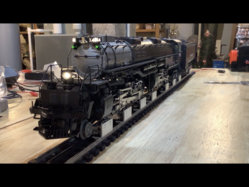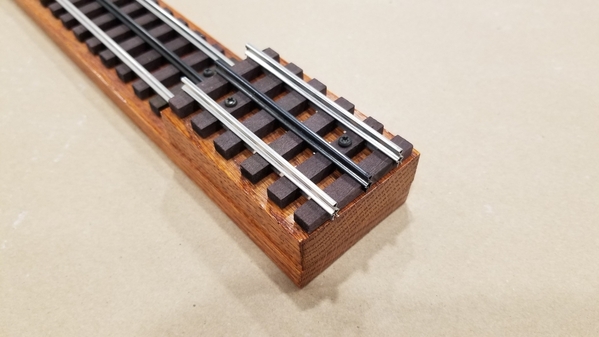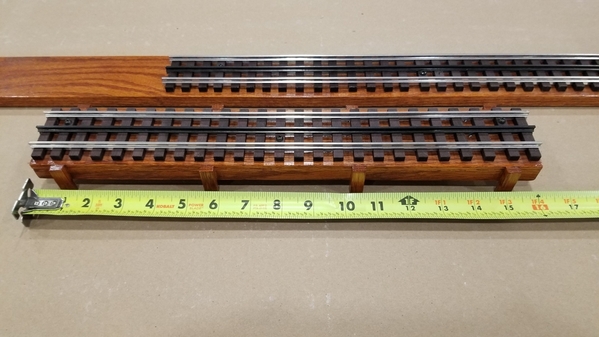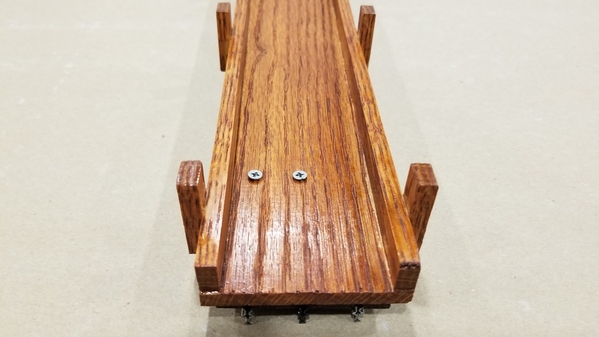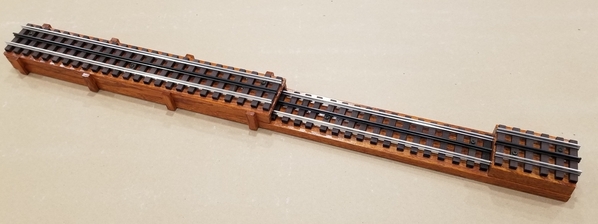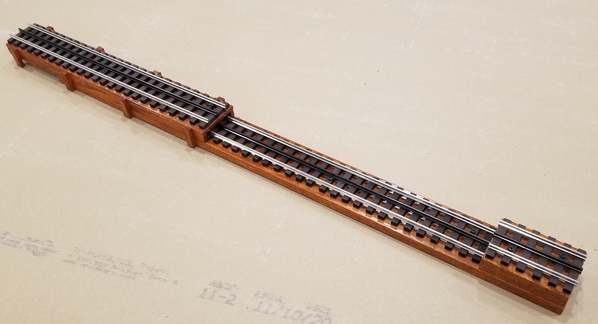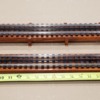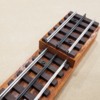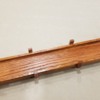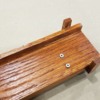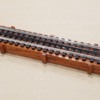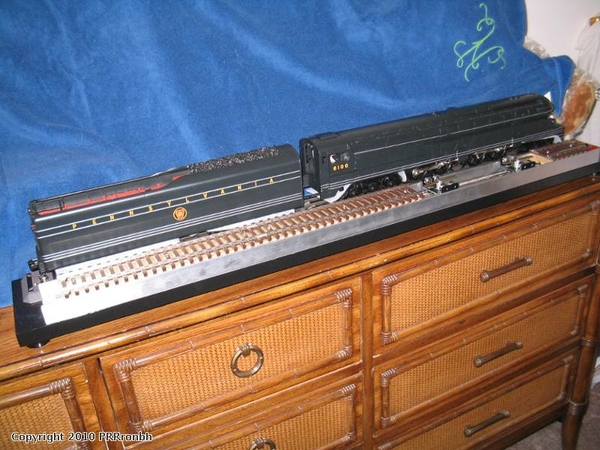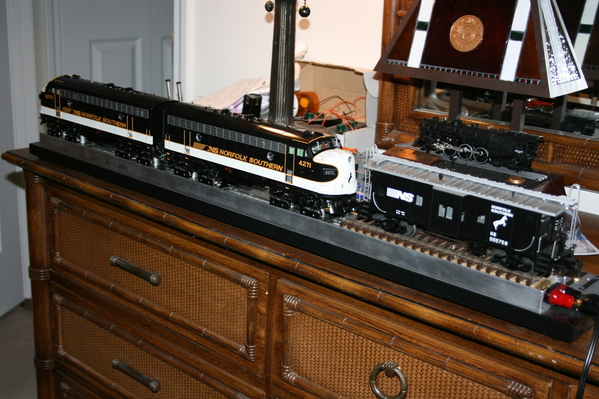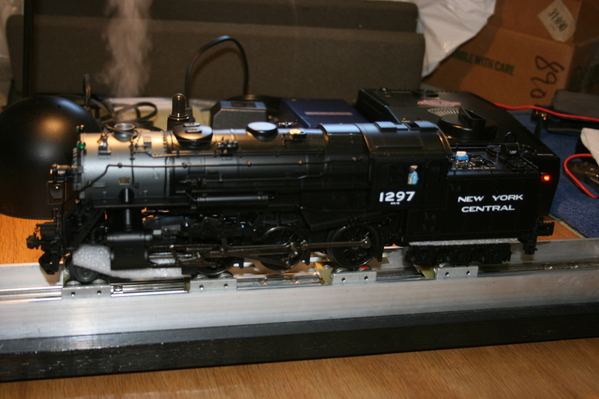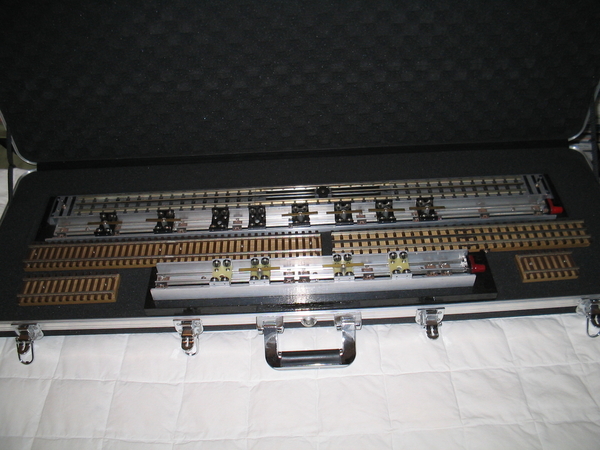With Christmas around the corner the kids are pestering me on something they can buy me. For those that use MM rollers, is three enough to start or should I have them order more??
Replies sorted oldest to newest
recommend 4 for a start...most loco's will use 4 some of the big steam might need more...joe
If you build a stand from wood and some spare/old track the package with 4 is enough even for articulateds. Just use a small 3/4" piece of wood under the pilot truck and you're good to go.
I like your sliding track section Joe, very tricky. ![]()
All of the rollers from Micro Mark comes with 4 sets of rollers to a package. One set has a pickup for the center rail. I bought one set and a year later, bought a second set. That way you'll have two pickups for the center rail. You will also be able to support all of the drivers.
Joe, would you be willing to share your design plans please?
They are sold as a set of four.
Bruce
I have found a set of 4 adequate for nearly everything. I don't have any articulateds.
On 6 axles diesels, I can put one at each end of the trucks. On 10 driver steamers, I just put them on the outer 2 sets at each end.
By the way, you don't have to set these on the track. I have a pair of wires from my track to my workbench with alligator clips on each wire. I can clip the alligator clips to the roller bases setting on my bench and run things that way. For 2 rail clip to each side, the bases are insulated, at least mine are. For 2 rail clip to one side and the center contact on the one.
I’d just go with one set and make a nice, small project with a base like the one Joe submits pictures of. I have two sets and it’s kind of a PITA to position them. YMMV
click photo to enlarge
Attachments
@Windy City posted:Joe, would you be willing to share your design plans please?
I don't have a design plan. It was made of scrap wood and some Gargraves track. The front elevated section is permanently attached to the base. The back portion can slide back and forth between the small vertical guides to accommodate different size locomotives. Here are some additional photos.
Attachments
Joe - Great design. How long did you make it??
If someone here decides to build one, and documents the construction step-by-step with a series of high-quality photos, he/she could submit it to the magazine and make an easy $200.
Jeff
It looks like about 3 feet.
Joe: ould you supply some dimension on yours please. How long is each section and the thickness I want to build one for me. Allan if I get what I need I amy take you up on the offer!
Bachmann/Williams is listing a 3rail "Rolling Road" that includes wheel cleaners for $159. Orders are being taken by Transworld for March 2021 delivery. Here is the link
Joe certainly has a winner there. Functional and looks like a piece of furniture. Mines on the crude side but functional. Built with 1x4’sand 1x2’s. Some rubber feet on the bottom. I don’t run large articulateds. Easily accommodates a 4-8-4. The front track adjusts to fit the pilot truck on shorter locos. The tender stays level with the engine. The aluminum angle just helps to support the side plates of the rollers. It’s just over 3 ft. Long.
Attachments
I'll measure mine up and post the dimensions either later tonight or tomorrow.
I have some. Don't like them. I have trouble with the locomotive's wobbling on them. Yes i put nuts on them. Didn't help.
Maybe I'm doing something wrong.
I just got a set of 4. Been wanting them for years.
@Trainlover9943 posted:I just got a set of 4. Been wanting them for years.
Just got my set as well!!
Sweet!
Mine is 36 inches long. Accommodates my largest locomotive (DM&IR Yellowstone) no problem. Only need 4 rollers as well.
I built mine as a Display Stand - strictly for this engine only. If I were building a Test Stand I would have made the sliding pieces.
Rick S, I’ve never been big on large articulateds. Just need huge curves and long consists to look right. But that setup is Sweet. What a great display. I love the wheel slip feature. Even though they aren’t slipping. The sounds give you the illusion they are. I knew the engine had this feature. Just haven’t ever heard it.
Lionel should offer this in all their Legacy engines.
Awesome thread. I was thinking about getting rollers and new to the hobby. Seeing their value and utility here has solidified my thoughts.
@Dave_C posted:Rick S, I’ve never been big on large articulateds. Just need huge curves and long consists to look right. But that setup is Sweet. What a great display. I love the wheel slip feature. Even though they aren’t slipping. The sounds give you the illusion they are. I knew the engine had this feature. Just haven’t ever heard it.
Lionel should offer this in all their Legacy engines.
Thank you for the kind words Dave. I always wanted one but knew it would never fit on my 8' x 15' layout. I joined a local train club the other year and as I was helping set up one of the very gentle corner sections I thought, "I could run a Big Boy on here!" And the quest began. . . After I got one, I made that stand so I could run it at home. I have some videos of my "long consist" on my YouTube channel.
An easy way to do a display only stand is to suspend the locomotive about 1/16" above the rails using some flat head screws. I use this technique for my York Meet Super-Chuffer display stand. No rollers, and the screws with rubber tops are spaced to drop into a recess here and there so the engine is stable.
Here is some general information on how my base was constructed. This is a sliding type roller base which will accommodate any size locomotive. The base is constructed of a piece of wood measuring 2-1/2" wide by 1/2" thick and 30" long. At the front end, a small piece of wood is fixed to the base. This is for support of the leading truck. I then attached track to the base and end piece as shown.
The sliding portion was constructed of three separate pieces of wood to form a "C" channel. It is 16" long. Four fingers were glued to each side. This allows the sliding portion to be re-positioned while staying in alignment with the rest of the base.
Two screws are inserted under the sliding portion so they screwed into the track on top. The heads of the screws are left protruding enough so that when the sliding piece is placed on the base, the screw heads will also contact the rail heads on the base track. This allows me to connect power wires to only the base track or sliding track but allow both to be powered. When I use this roller base for testing, I just connect power wires to the exposed sliding track. If I use the base for display purposes, I connect the power wires to the base track, This way the wires are partially hidden under the sliding portion.
Here are some photos of the sliding portion in different positions. It really can handle just about any size locomotive. Of course the bigger the locomotive the more rollers you will need.
Attachments
Love your design Joe. What were the lumber dimensions you used? Off the shelf stuff or custom cut?
Most of the important dimensions are listed above.
You do not need to set the roller stands on track. I have used mine for years without that. I have a set of test leads with alligator clips routed onto my work desk. I use them when cleaning loco wheels. I put the loco in a cradle upside down and connect the leads to proper contacts to power it. Then I can run the wheels and clean them.
I also use the leads by connect them with the alligator clips to two of my roller stands setting on the work desk. Since the loco is not moving along, putting power to just one set of wheels does the job just fine. I connect the leads to roller stands and I can run the loco on the bench for whatever needs I have.
I have found that the roller stands are much more stable setting on the bench than setting on section of track. Setting on the track raises them another half inch. I don't want a loco to tumble over while on the rollers.
Joe's design is handsome for a test track, but Rick's whole set up takes the cake for sexiness. it makes me want to go out and buy a big engine just for display.
But for economy and simplicity you could just do something like John does. Or even with a set up like Joe's, couldn't you eliminate the rollers all together and have some metal bars in the dropped down center section that contact the rollers and hold the weight of the engine but the drivers would run free? Maybe to tippy? The tender, pilot and trailing truck would still be on the upper level.
I want to hear more about what John does- where does he put the screws?
@Will posted:I want to hear more about what John does- where does he put the screws?
My display stand was customized for the engine I was using, so I put the screws where the head would drop into a screw recess in the locomotive frame. That makes it sit very stable and just suspends it slightly above the rail.
@gunrunnerjohn posted:My display stand was customized for the engine I was using, so I put the screws where the head would drop into a screw recess in the locomotive frame. That makes it sit very stable and just suspends it slightly above the rail.
Very clever. So the rollers and pilot wheels and tender still contact the track, I assume, providing power?
Yep, I just suspended the drivers about 1/16" above the track, everything else sits directly on the track. Since the tender is still hooked to the locomotive, everything is stable and even if you bump the stand, nothing moves. I used to have issues with knocking the display engine off the rollers when I had it up on rollers. I got the idea of suspending it on the screws from other displays in the Orange Hall at York. Some of the large scale guys had stuff suspended like that and it looked really cool and worked well.
I did what John suggested when I posted this video a week or so ago. Works great.
https://ogrforum.ogaugerr.com/...3#153603996847757973
John




